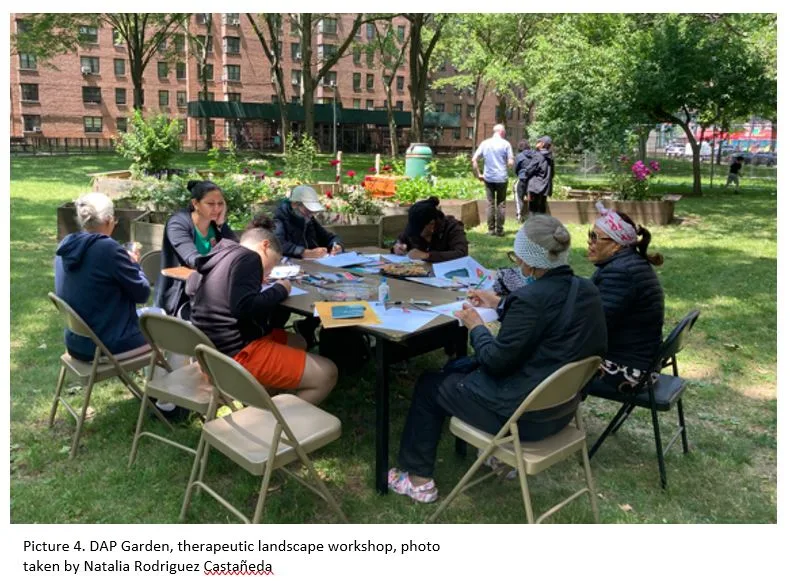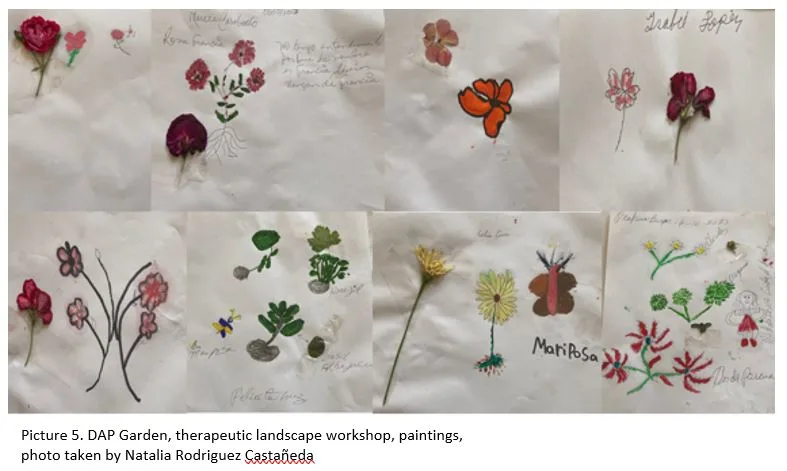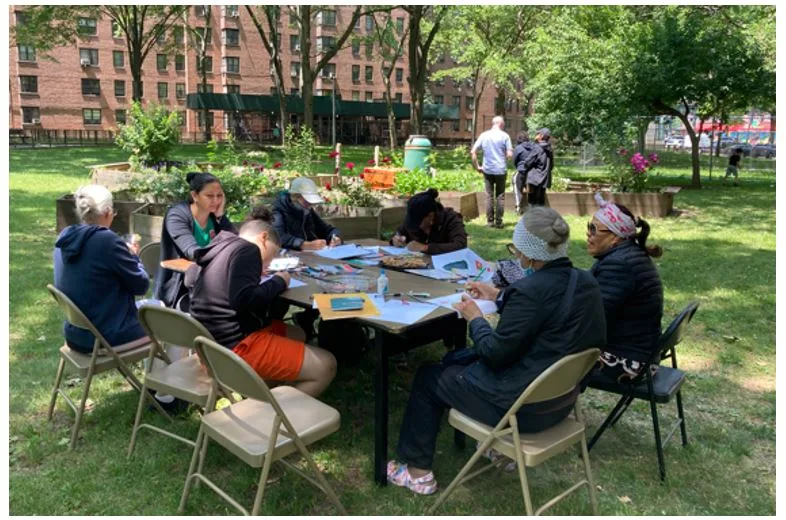By Natalia Rodriguez Castañeda,
Social, Environmental and Health Anthropologist,
PhD Candidate in the NovelEco ERC Team, Trinity College Dublin.
Celebrating cultural heritage through contact with nature in allotment gardens, a reflection from therapeutic landscape workshops in gardens in the Bronx, New York
Unlike novel ecosystems or wild spaces in cities that are characterised by the lack of
anthropogenic activity and the growth of spontaneous vegetation, allotment gardens
are mainly spaces shaped, designed and planted by people. In these urban natural and
semi-natural spaces, contact with nature is mediated by the art of seeding and growing
plants, taking care of them, and learning about their ecological and cultural value.
Moreover, as is the case in community gardens such as OSS#MH and OSS#DK DAP in
the Bronx, New York, these spaces invite to embody, exchange and celebrate cultural
heritage and identity through gardening.
In June 2023, the research group NovelEco had the opportunity to conduct two
Therapeutic landscape workshops in community gardens located in the Bronx, New
York. The first workshop was conducted in the edible or food garden, OSS#MH, located
in Northwest Bronx (picture. 1). The second workshop was carried out in the flowers
and herbs OSS#DK DAP, located in the complex building of Dyckman houses on 204 th
Street and Nagle Avenue (picture 2). In both spaces, we worked with Hispanic,
Caribbean and African-American communities. The two workshops were conducted in
collaboration with the OSS Project and the artist Juanli Carrion from The New School in
New York.
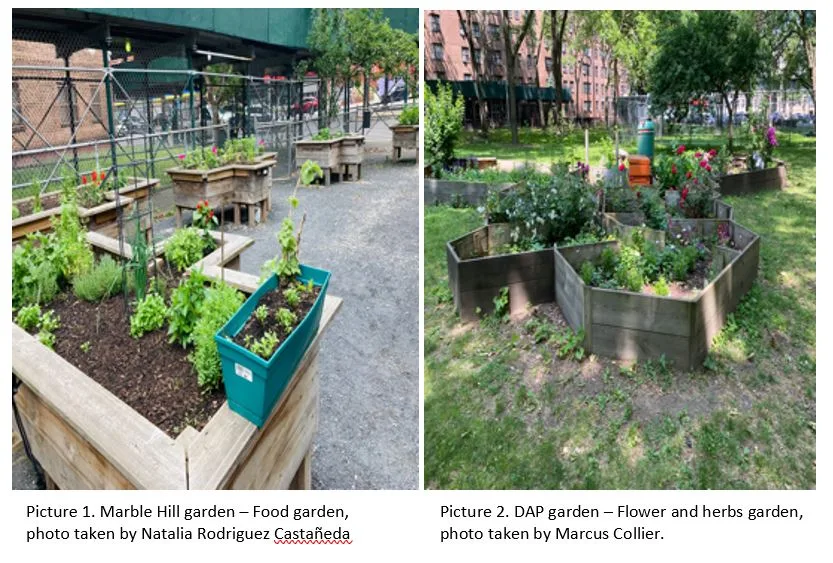
Edible therapeutic garden!
The first workshop was conducted in OSS#MH inspired to understand the value of this
community garden to exchange knowledge, stories and flavours around edible plants,
herbs, vegetables and fruits. Through the plants’ different aromas, colours and
textures, we created a space to celebrate cultural heritage by connecting plants with
ingredients, senses and tastes that remind us of local food from the Caribbean, Latin
America and North America.
This workshop explored the food potential of this garden to cook together with the
participants: tortillas (Picture 3). We used the tortillas, a thin round bread made of
corn – masa de maíz – popular in México and Central America and with its history in
the cuisine of this region from pre-colonial times, as a kind of canvas, ready to be
painted or filled with different ingredients, senses, colours, textures, and aromas to
eat and enjoy together.
First, we asked our participants to gather plants, herbs, fruits, vegetables, roots and
leaves growing in the garden to make their tortillas. Then, we asked them to make
their tortillas, considering and reflecting on how the ingredients were linked to
traditional recipes, stories, and personal tastes. Some of the participants chose spicy
ingredients, coming from Mexico and Thailand; others mixed fruits and vegetables,
combining sweet and salty. People were also inspired and guided by colours, smells
and textures when choosing the ingredients – plants.
While we enjoyed the tortillas, we thought about how this exercise was an opportunity
to embody the landscape through our senses, bringing our emotions, memories and
knowledge about plants to the table. We discussed how Marble Hill Garden is a space
to share with more people, bringing knowledge, fascination and curiosity for plants
into the city.
Finally, this workshop gave us insights into the value and importance of community
gardens in a big and dense city like New York. In this opportunity, Marble Hill
represents an opportunity to enhance health equality, accessibility, nature
connectedness, and social cohesion, creating a space for food literacy and celebrating
cultural heritage and local knowledge.
Thanks, gardeners from OSS#MH, for participating in this workshop! It was a tasty and
lovely time with you!
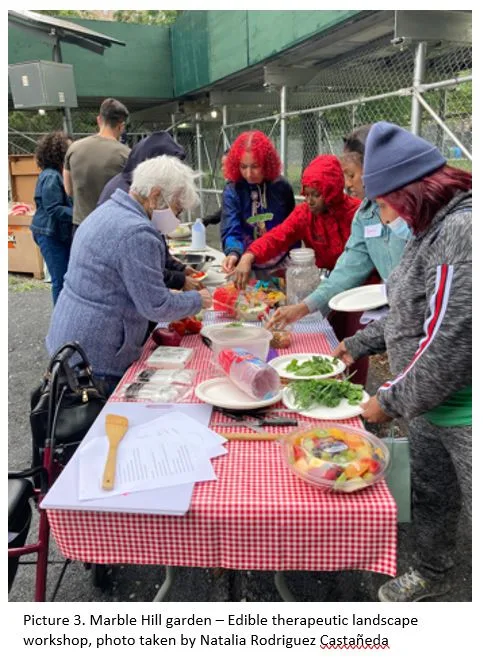
Aesthetic and healing landscape: The restorative value of flowers and herbs in a
therapeutic garden
The second workshop was conducted in OSS#DK DAP, where gardeners grow flowers
and herbs, making this space aesthetically beautiful, colourful and with the smell of
flowers and culinary herbs such as basil (orégano) or thyme (tomillo). The plants
growing in this garden are selected based on their aesthetic, ornamental and healing
properties.
When we conducted the therapeutic landscape workshop, we asked the participants
to walk around the garden and choose interesting or pretty plants. When they finished
their walk, we asked them to sit together to paint and exchange their knowledge
about the selected plants and their reason for including them in the Therapeutic
herbarium (Picture 4 & 5). Through paintings and conversations, we got insights into
how the relationship with plants was intertwined with stories, experiences,
perceptions and aesthetic values attributed to the different plant species. For example,
flowers, mainly roses, were primarily chosen because of their vivid colours and
pleasant smell. Herbs such as basil and thyme were attributed to medicinal properties
and traditional uses to heal and calm headaches and stomachaches.
In the DAP Garden, the therapeutic landscape was associated with ornamental and
aesthetic characteristics and medicinal properties attributed to plants to heal the physical body. In this space, the therapeutic features involve visual and appearance aspects, local knowledge, healing properties and socio-cultural values, which create a therapeutic landscape atmosphere inviting people to come and spend time with plants, insects, birds and other gardeners.
Finally, as a general reflection of this experience, when we conducted the workshop at
OSS#MH and OSS#DK DAP, we heard how participants asked each other: What are you
growing there? After our workshops, the answer to this question is that they are
growing various plants that embody, celebrate and envision the community and their
cultural identity, heritage and traditional knowledge.
Thanks, gardeners from OSS#DK DAP, for participating in this workshop! It was a
pleasant and lovely time with you!
